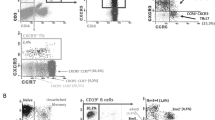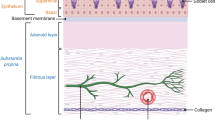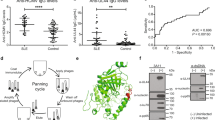Abstract
Evidence from certain geographical areas links lymphomas of the ocular adnexa marginal zone B-cell lymphomas (OAMZL) with Chlamydophila psittaci (Cp) infection, suggesting that lymphoma development is dependent upon chronic stimulation by persistent infections. Notwithstanding that, the actual immunopathogenetical mechanisms have not yet been elucidated. As in other B-cell lymphomas, insight into this issue, especially with regard to potential selecting ligands, could be provided by analysis of the immunoglobulin (IG) receptors of the malignant clones. To this end, we studied the molecular features of IGs in 44 patients with OAMZL (40% Cp-positive), identifying features suggestive of a pathogenic mechanism of autoreactivity. Herein, we show that lymphoma cells express a distinctive IG repertoire, with electropositive antigen (Ag)-binding sites, reminiscent of autoantibodies (auto-Abs) recognizing DNA. Additionally, five (11%) cases of OAMZL expressed IGs homologous with autoreactive Abs or IGs of patients with chronic lymphocytic leukemia, a disease known for the expression of autoreactive IGs by neoplastic cells. In contrast, no similarity with known anti-Chlamydophila Abs was found. Taken together, these results strongly indicate that OAMZL may originate from B cells selected for their capability to bind Ags and, in particular, auto-Ags. In OAMZL associated with Cp infection, the pathogen likely acts indirectly on the malignant B cells, promoting the development of an inflammatory milieu, where auto-Ags could be exposed and presented, driving proliferation and expansion of self-reactive B cells.
This is a preview of subscription content, access via your institution
Access options
Subscribe to this journal
Receive 12 print issues and online access
$259.00 per year
only $21.58 per issue
Buy this article
- Purchase on Springer Link
- Instant access to full article PDF
Prices may be subject to local taxes which are calculated during checkout

Similar content being viewed by others
Accession codes
Accessions
GenBank/EMBL/DDBJ
References
Ferreri AJ, Dolcetti R, Du MQ, Doglioni C, Resti AG, Politi LS et al. Ocular adnexal MALT lymphoma: an intriguing model for antigen-driven lymphomagenesis and microbial-targeted therapy. Ann Oncol 2008; 19: 835–846.
Mannami T, Yoshino T, Oshima K, Takase S, Kondo E, Ohara N et al. Clinical, histopathological, and immunogenetic analysis of ocular adnexal lymphoproliferative disorders: characterization of malt lymphoma and reactive lymphoid hyperplasia. Mod Pathol 2001; 14: 641–649.
Hyjek E, Isaacson PG . Primary B cell lymphoma of the thyroid and its relationship to Hashimoto's thyroiditis. Hum Pathol 1988; 19: 1315–1326.
Hyjek E, Smith WJ, Isaacson PG . Primary B-cell lymphoma of salivary glands and its relationship to myoepithelial sialadenitis. Hum Pathol 1988; 19: 766–776.
Wotherspoon AC, Ortiz-Hidalgo C, Falzon MR, Isaacson PG . Helicobacter pylori-associated gastritis and primary B-cell gastric lymphoma. Lancet 1991; 338: 1175–1176.
Zucca E, Bertoni F, Roggero E, Bosshard G, Cazzaniga G, Pedrinis E et al. Molecular analysis of the progression from Helicobacter pylori-associated chronic gastritis to mucosa-associated lymphoid-tissue lymphoma of the stomach. N Engl J Med 1998; 338: 804–810.
Garbe C, Stein H, Dienemann D, Orfanos CE . Borrelia burgdorferi-associated cutaneous B cell lymphoma: clinical and immunohistologic characterization of four cases. J Am Acad Dermatol 1991; 24: 584–590.
Ferreri AJ, Guidoboni M, Ponzoni M, De Conciliis C, Dell′Oro S, Fleischhauer K et al. Evidence for an association between Chlamydia psittaci and ocular adnexal lymphomas. J Natl Cancer Inst 2004; 96: 586–594.
Ferreri AJ, Ponzoni M, Guidoboni M, De Conciliis C, Resti AG, Mazzi B et al. Regression of ocular adnexal lymphoma after Chlamydia psittaci-eradicating antibiotic therapy. J Clin Oncol 2005; 23: 5067–5073.
Ferreri AJ, Dolcetti R, Magnino S, Doglioni C, Cangi MG, Pecciarini L et al. A woman and her canary: a tale of chlamydiae and lymphomas. J Natl Cancer Inst 2007; 99: 1418–1419.
Coupland SE, Foss HD, Anagnostopoulos I, Hummel M, Stein H . Immunoglobulin VH gene expression among extranodal marginal zone B-cell lymphomas of the ocular adnexa. Invest Ophthalmol Vis Sci 1999; 40: 555–562.
Bahler DW, Szankasi P, Kulkarni S, Tubbs RR, Cook JR, Swerdlow SH . Use of similar Ig VH gene segments by MALT lymphomas of the ocular adnexa. Mod Pathol 2009; 22: 833–838.
Hara Y, Nakamura N, Kuze T, Hashimoto Y, Sasaki Y, Shirakawa A et al. Immunoglobulin heavy chain gene analysis of ocular adnexal extranodal marginal zone B-cell lymphoma. Invest Ophthalmol Vis Sci 2001; 42: 2450–2457.
Adam P, Haralambieva E, Hartmann M, Mao Z, Ott G, Rosenwald A . Rare occurrence of IgVH gene translocations and restricted IgVH gene repertoire in ocular MALT-type lymphoma. Haematologica 2008; 93: 319–320.
Hussell T, Isaacson PG, Crabtree JE, Spencer J . The response of cells from low-grade B-cell gastric lymphomas of mucosa-associated lymphoid tissue to Helicobacter pylori. Lancet 1993; 342: 571–574.
Hussell T, Isaacson PG, Crabtree JE, Spencer J . Helicobacter pylori-specific tumour-infiltrating T cells provide contact dependent help for the growth of malignant B cells in low-grade gastric lymphoma of mucosa-associated lymphoid tissue. J Pathol 1996; 178: 122–127.
Hussell T, Isaacson PG, Crabtree JE, Dogan A, Spencer J . Immunoglobulin specificity of low grade B cell gastrointestinal lymphoma of mucosa-associated lymphoid tissue (MALT) type. Am J Pathol 1993; 142: 285–292.
Bende RJ, Aarts WM, Riedl RG, de Jong D, Pals ST, van Noesel CJ . Among B cell non-Hodgkin's lymphomas, MALT lymphomas express a unique antibody repertoire with frequent rheumatoid factor reactivity. J Exp Med 2005; 201: 1229–1241.
Ferreri AJ, Dolcetti R, Magnino S, Doglioni C, Ponzoni M . Chlamydial infection: the link with ocular adnexal lymphomas. Nat Rev Clin Oncol 2009; 6: 658–669.
Swerdlow SHCE, Harris NL, Jaffe ES, Pileri SA, Stein H, Thiele J et al. WHO Classification of tumours of haematopoietic and lymhoid tissues. International Agency for Research on CANCER (IARC): Lyon, 2008.
Madico G, Quinn TC, Boman J, Gaydos CA . Touchdown enzyme time release-PCR for detection and identification of Chlamydia trachomatis, C pneumoniae, and C psittaci using the 16S and 16S-23S spacer rRNA genes. J Clin Microbiol 2000; 38: 1085–1093.
Hill JE, Goh SH, Money DM, Doyle M, Li A, Crosby WL et al. Characterization of vaginal microflora of healthy, nonpregnant women by chaperonin-60 sequence-based methods. Am J Obstet Gynecol 2005; 193: 682–692.
Fais F, Ghiotto F, Hashimoto S, Sellars B, Valetto A, Allen SL et al. Chronic lymphocytic leukemia B cells express restricted sets of mutated and unmutated antigen receptors. J Clin Invest 1998; 102: 1515–1525.
Ramasamy I, Brisco M, Morley A . Improved PCR method for detecting monoclonal immunoglobulin heavy chain rearrangement in B cell neoplasms. J Clin Pathol 1992; 45: 770–775.
Kostareli E, Sutton LA, Hadzidimitriou A, Darzentas N, Kouvatsi A, Tsaftaris A et al. Intraclonal diversification of immunoglobulin light chains in a subset of chronic lymphocytic leukemia alludes to antigen-driven clonal evolution. Leukemia 2010; 24: 1317–1324.
Murray F, Darzentas N, Hadzidimitriou A, Tobin G, Boudjogra M, Scielzo C et al. Stereotyped patterns of somatic hypermutation in subsets of patients with chronic lymphocytic leukemia: implications for the role of antigen selection in leukemogenesis. Blood 2008; 111: 1524–1533.
Gerstenbruch S, Brooks CL, Kosma P, Brade L, MacKenzie CR, Evans SV et al. Analysis of cross-reactive and specific anti-carbohydrate antibodies against lipopolysaccharide from Chlamydophila psittaci. Glycobiology 2010; 20: 461–472.
Muller-Loennies S, Gronow S, Brade L, MacKenzie R, Kosma P, Brade H . A monoclonal antibody against a carbohydrate epitope in lipopolysaccharide differentiates Chlamydophila psittaci from Chlamydophila pecorum, Chlamydophila pneumoniae, and Chlamydia trachomatis. Glycobiology 2006; 16: 184–196.
Darzentas N, Hadzidimitriou A, Murray F, Hatzi K, Josefsson P, Laoutaris N et al. A different ontogenesis for chronic lymphocytic leukemia cases carrying stereotyped antigen receptors: molecular and computational evidence. Leukemia 2010; 24: 125–132.
Tamura K, Peterson D, Peterson N, Stecher G, Nei M, Kumar S . MEGA5: Molecular Evolutionary Genetics Analysis using Maximum Likelihood, Evolutionary Distance, and Maximum Parsimony Methods. Mol Biol Evol 2011; 28: 2731–2739; In press.
O'Keefe TL, Bandyopadhyay S, Datta SK, Imanishi-Kari T . V region sequences of an idiotypically connected family of pathogenic anti-DNA autoantibodies. J Immunol 1990; 144: 4275–4283.
Ferreri AJ, Dolcetti R, Dognini GP, Malabarba L, Vicari N, Pasini E et al. Chlamydophila psittaci is viable and infectious in the conjunctiva and peripheral blood of patients with ocular adnexal lymphoma: results of a single-center prospective case-control study. Int J Cancer 2008; 123: 1089–1093.
Ponzoni M, Ferreri AJ, Guidoboni M, Lettini AA, Cangi MG, Pasini E et al. Chlamydia infection and lymphomas: association beyond ocular adnexal lymphomas highlighted by multiple detection methods. Clin Cancer Res 2008; 14: 5794–5800.
Matthews JM, Moreno LI, Dennis J, Byrne Jr GE, Ruiz P, Dubovy SR et al. Ocular adnexal lymphoma: no evidence for bacterial DNA associated with lymphoma pathogenesis. Br J Haematol 2008; 142: 246–249.
Xu JL, Davis MM . Diversity in the CDR3 region of V(H) is sufficient for most antibody specificities. Immunity 2000; 13: 37–45.
Davies DR, Cohen GH . Interactions of protein antigens with antibodies. Proc Natl Acad Sci USA 1996; 93: 7–12.
Barrios Y, Jirholt P, Ohlin M . Length of the antibody heavy chain complementarity determining region 3 as a specificity-determining factor. J Mol Recognit 2004; 17: 332–338.
Messmer BT, Albesiano E, Efremov DG, Ghiotto F, Allen SL, Kolitz J et al. Multiple distinct sets of stereotyped antigen receptors indicate a role for antigen in promoting chronic lymphocytic leukemia. J Exp Med 2004; 200: 519–525.
Chothia C, Lesk AM, Gherardi E, Tomlinson IM, Walter G, Marks JD et al. Structural repertoire of the human VH segments. J Mol Biol 1992; 227: 799–817.
Lanemo M A, Hellqvist E, Sidorova E, Soderberg A, Baxendale H, Dahle C et al. A new perspective: molecular motifs on oxidized LDL, apoptotic cells, and bacteria are targets for chronic lymphocytic leukemia antibodies. Blood 2008; 111: 3838–3848.
Stamatopoulos K, Belessi C, Moreno C, Boudjograh M, Guida G, Smilevska T et al. Over 20% of patients with chronic lymphocytic leukemia carry stereotyped receptors: pathogenetic implications and clinical correlations. Blood 2007; 109: 259–270.
Acknowledgements
This work was in part supported by Associazione Italiana per la Ricerca sul Cancro (AIRC, Milan, to PG and RD), Progetti di Ricerca di Interesse Nazionale (PRIN), Progetto Integrato Oncologia (PIO), Fondazione CARIPLO, Milan; and the ENosAI project (code 09SYN-13-880), co-funded by the EU and the Hellenic General Secretariat for Research and Technology (to KS). Elisa Pasini is a fellow of the Fondazione Italiana per la Ricerca sul Cancro (FIRC).
Author information
Authors and Affiliations
Corresponding author
Ethics declarations
Competing interests
The authors declare no conflict of interest.
Rights and permissions
About this article
Cite this article
Dagklis, A., Ponzoni, M., Govi, S. et al. Immunoglobulin gene repertoire in ocular adnexal lymphomas: hints on the nature of the antigenic stimulation. Leukemia 26, 814–821 (2012). https://doi.org/10.1038/leu.2011.276
Received:
Revised:
Accepted:
Published:
Issue Date:
DOI: https://doi.org/10.1038/leu.2011.276
Keywords
This article is cited by
-
Profiling the B/T cell receptor repertoire of lymphocyte derived cell lines
BMC Cancer (2018)
-
Chlamydia psittaci in Ocular Adnexal MALT Lymphoma: a Possible Causative Agent in the Pathogenesis of This Disease
Current Clinical Microbiology Reports (2018)
-
Molecular pathogenesis of lymphomas of mucosa-associated lymphoid tissue—from (auto)antigen driven selection to the activation of NF-κB signaling
Science China Life Sciences (2015)
-
Clinical Aspects of Malt Lymphomas
Current Hematologic Malignancy Reports (2014)
-
A novel chronic lymphocytic leukemia subset expressing mutated IGHV3-7-encoded rheumatoid factor B-cell receptors that are functionally proficient
Leukemia (2013)



